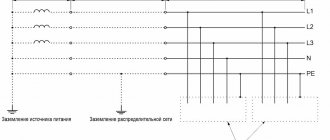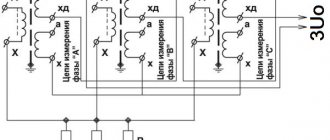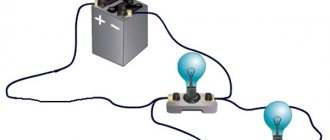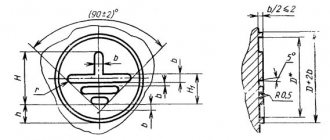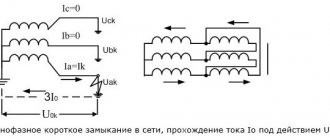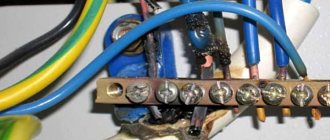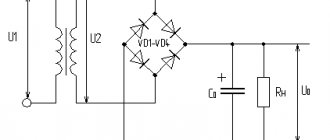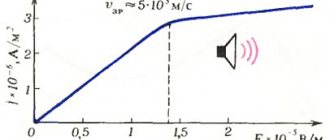Protective grounding of electrical installations
Grounding is a deliberate electrical connection of open conductive elements of electrical installations, which are not in a normal state under voltage, with a solidly grounded neutral point of a transformer or generator in three-phase power networks; with a grounded source point in DC power networks; with a solidly grounded output of a single-phase electric current source. The purpose of grounding is to ensure electrical safety.
Grounding differs from grounding in that it is designed for the effect of a short circuit.
If the distribution of loads in production is more or less uniform, and the neutral conductor mainly performs protective functions, then in this case the “zero” clings to the body of the electric motor.
A short circuit occurs when voltage from one of the phases reaches the body of the electric motor.
In this case, a difavtomat or a regular circuit breaker is triggered to shut down. It should also be noted that through the use of a metal grounding bus, all industrial electrical installations are connected to each other, which are connected to the common grounding circuit of the entire building.
How to ground electrical equipment
Next, we will talk about where the protective grounding comes from into our house, and consider its path from the transformer substation and whether it is safe to carry out grounding in the apartment. This grounding begins with a solidly grounded neutral - connected to the grounding device of the neutral of the power transformer.
The neutral, together with the three-phase line, first enters the input cabinet. From there it is distributed to the electrical panels located on the floors.
The working zero is taken from it, which together with the phase forms the phase voltage that is familiar to us. The name “working zero” is due to the fact that it is used to operate electrical installations or electrical appliances.
A separate protective zero taken from the electrical panel, which has an electrical connection with a solidly grounded neutral, forms a protective ground . It is imperative to know that there should be no switching devices (automatic machines, switches, etc.) or fuses in the circuit of protective grounding conductors.
Scope of application of protective grounding
Protective grounding is used in electrical installations with voltages up to 1 kV:
The formation of a single-phase short circuit current circuit (i.e. a short circuit between the neutral and phase protective conductors) occurs in the event of a phase wire shorting to a grounded housing of the electrical consumer. The damaged electrical installation is disconnected from the supply network due to the activation of protection caused by single-phase short circuit current.
To quickly disconnect the electrical installation located, circuit breakers and fuses installed to protect against short circuit currents can be used. Also for this purpose, magnetic starters with built-in thermal protection, contactors with thermal relays are used, which provide overload protection, etc.
Operating principle of protective grounding
A short circuit occurs when a phase wire (voltage) contacts the metal body of the device connected to the neutral conductor. In this case, an increase in the current strength in the circuit to enormous values is recorded, as a result of which protective devices are activated, which turn off the line supplying the faulty device.
The automatic shutdown time of a damaged power line for phase voltage of the network 380/220 V, in accordance with the PUE, should not exceed 0.4 seconds.
To carry out grounding, specially designed conductors are used, for example, the third core of a cable or wire in the case of single-phase wiring.
The “phase-zero” loop should have a small resistance, because only in this case the protective device is switched off within the time specified by the rules. Therefore, effective grounding can only be achieved with high quality of all connections and network installation.
Grounding allows you to ensure not only a quick disconnection of the faulty line from electricity, but also, thanks to the grounding of the neutral, a low touch voltage on the body of the electrical device. Thanks to this, the possibility of electric shock to the human body is eliminated. A grounded neutral gives rise to calling grounding a certain type of grounding.
Consequently, the basis for the operating principle of protective grounding is the transformation of a short circuit to the housing into a single-phase short circuit. to call a high current protection that triggers, the ultimate goal of which is to disconnect the damaged electrical installation from the network.
Why is zeroing in an apartment dangerous?
Grounding is significantly different from grounding. Let's try to look at this difference in more detail. In accordance with the PUE, the use of such deliberate protection as zeroing at the household level is prohibited due to its unsafety.
But, despite the fact that such a system should only be practiced in industrial production, many people install it in their apartments. They resort to this less-than-perfect defense, in particular, due to the lack of another option or due to a lack of knowledge in this area.
Indeed, zeroing in an apartment , but the consequences of this will be far from the best. Next, using examples, we will consider some situations that may arise if grounding is performed in an apartment.
1) Grounding in sockets
Sometimes it is proposed to “ground” electrical appliances by jumping the working zero terminal in the socket to a protective contact. This method of “grounding” does not comply with the requirements of clause 1.7.132 of the PUE, because it implies the use of the neutral conductor of a two-wire network as a protective and working zero at the same time.
In addition, at the entrance to the apartment there is usually a device designed for switching both phase and zero, for example, a packager or a two-pole device. But it is prohibited to switch the neutral conductor, which is used as a protective conductor. That is, a conductor whose circuit has a switching device cannot be used as a protective conductor.
The danger of “grounding” with a jumper in a socket is that the housings of electrical appliances, if the integrity of the zero is broken anywhere, will be under phase voltage. If the neutral wire breaks, the operation of the electrical receiver is interrupted, and then such a wire appears de-energized, that is, safe, which, of course, aggravates the situation.
One can only imagine how much trouble such an outlet would cause if a washing machine was plugged into it. In this case, you can see a jumper that connects the “zero” contact to the protective one. And if the “zero” burned out, then such a washing machine would turn into a “killer”.
If, while a person is taking a shower, zero “snot” falls out in the socket to which the boiler is connected, such a person will simply be electrocuted. Therefore, such grounding in an apartment is extremely dangerous and is prohibited.
2) Phase and zero are reversed
By looking at the following example, you can clearly see the most likely danger in a two-wire riser. Often, when carrying out any repair work in household electrical equipment, zero “N” is mistakenly swapped with phase “L”.
The cores of the wires in the electrical panel in houses with two-wire wiring do not have a distinctive color, and when performing any work in the panel, any electrician can switch the zero and phase in places - the housings of electrical appliances in this case will also be under phase voltage.
It is imperative to remember the high danger of performing protective grounding in a two-wire system. Therefore, according to the rules, this is prohibited!
3) Zero burnout
Every electrician knows what “zero burnout” or zero break is, but not every electricity consumer knows. Let's try to understand the meaning of this phrase and find out what is the danger of zero burning?
Very often, a break in the “zero” is fixed in houses with old wiring, the basis for the design of which was the calculation of approximately 2 kW per apartment. Of course, the current equipment of apartments with all kinds of electrical appliances increases these figures by an order of magnitude.
In the event of a “zero” break, a phase imbalance can occur at the transformer substation from which a multi-storey building is powered, in a common electrical panel or in a panel on the landing of this house, in a power line located after this break. The result may be that one part of the apartments receives low voltage, and another part receives high voltage.
Low voltage is dangerous for refrigerators, air conditioners, split systems, hoods, fans and other equipment with electric motors. As for the increased voltage, any household appliance can fail.
Conversion of the old TN-C power system to match the TN-CS system
The PE conductor is additionally connected to the grounding device of the house (re-grounding is performed).
In order to transfer the power system to a more advanced TN-CS, the PEN conductor is divided into PE - protective and N - neutral. By its principle, the TN-CS system is that the PEN conductor approaching the house at the input distribution device (IDU) is divided into two separate ones and in this form approaches the end consumer.
Socket with grounding contacts
The design of the sockets is such that when turned on, the grounding terminals are closed first, and only then the terminals with phase and neutral conductors. Neutral (neutral conductor is used to transmit electrical energy to the consumer, and protective to ensure safety.
What is the neutral wire for? What is a neutral wire
Novice electricians often have a question: “Which wire is the neutral wire in the home power supply system?” To answer this question, you should know that the neutral wire is necessary to avoid “phase imbalance”. Experts strive to achieve a uniform load when supplying electricity to consumers.
To clearly explain this phenomenon, let’s take as an example an apartment building, where an equal number of apartments are connected to one of three phases. However, uneven consumption in this case still remains. After all, people in each apartment use different electrical appliances at different times of the day and night.
The principle of operation of the neutral wire
Electricity comes to consumers from a voltage transformer, which is capable of converting the voltage of an industrial network into the secondary winding of the transformer is connected in a star circuit, i.e. three wires are connected at one zero point. The second end of the high-voltage wires is connected to terminals called A, B and C.
The ends connected together at the zero point are connected to the ground loop in the substation. There, the high-voltage wire of zero resistance is also divided into:
According to the scheme described above, it works in new buildings. It is called the TN-S system. In the building's switchboard, electricians supply 3 phases, a PE conductor, and a neutral wire.
Most old apartment buildings do not have a PE conductor. The power supply system consists of 4 wires, it is called TN-C. It is outdated and considered unsafe. In this case, the neutral wire is grounded at home.
The phases and zero from the voltage transformer are carried to residential premises by underground or above-ground high-voltage wires, subsequently connecting them to the input panel of the house. This creates a three-phase system with a voltage of 380/220 volts.
From the input panel, electricians route wires to entrances and apartments. Electricity is supplied to consumers using wires connected to one of three phases with a network voltage of 220 volts.
Also, a PE protective wire (only when using the new TN-S system) and a neutral wire are installed in the living space.
When zero-resistance wires are connected to each electricity consumer, the uneven load on the electrical network practically disappears.
Why is PE protective conductor needed?
A protective conductor or PE is necessary for additional protection of the home. In the event of a short circuit, it diverts current from the location where the wiring is damaged, thereby protecting people from electric shock and property from fire.
In such a network, the load is distributed evenly, since each floor of an apartment building is wired in phases.
The electrical system connected to residential premises is a “star”, which repeats all the vector characteristics of the transformer substation.
Such a system is reliable and optimal, but it also has its drawbacks, since malfunctions periodically occur. Most often, power outages are associated with poor quality wires, as well as poor-quality connections.
Causes of breakage in zero and phases
If there is poor contact between the wires and increased loads on the power supply system, the network breaks.
If any of the three conductors powering the house breaks, consumers connected to it will not receive electricity. At the same time, other consumers who are connected to the remaining two phases receive electricity in full. The current in the neutral wire is summed up from the phases remaining in working condition and will be equal to this value.
All breaks in the network are associated with a power outage to the apartments. Such accidents cannot damage electrical appliances.
Dangerous situations that threaten indoor fire and equipment breakdown occur if the connection between the voltage transformer at the substation and the distribution panel is broken.
This situation occurs due to many factors, but the most likely cause of power outages is due to an error by the electrician crew.
Causes of short circuit
A short circuit becomes possible when the current does not pass through “zero” to the ground loop A0, B0 and C0. Instead, the currents move along the external circuits AB, BC and CA, which are powered by a voltage of 360 volts.
Thus, on one panel of the apartment there may be too little voltage, since the frugal tenant has turned off all electrical appliances, and on the other, a voltage close to linear is formed - 360 volts. This causes damage to the wires.
The devices, in turn, overheat as a result of the supply of off-design currents to them.
To avoid such a situation and protect against a sudden surge in voltage, there are protection devices that are installed inside apartment panels. They are also placed in the housing of expensive electrical appliances to prevent breakdowns, for example, in refrigerators and freezers.
Method for determining zero and phase in a house
To identify a fault in the electrical wiring at home, most often they use a budget screwdriver with a light indicator. Such a device works due to the passage of capacitive current inside its body. The internal part of such a device is equipped with the following components:
Experienced electricians purchase more functional devices for troubleshooting, for example, a multifunctional electronic indicator in the form of a screwdriver, powered by two batteries, thanks to which the device is capable of creating a voltage of 3 volts. In addition to phase detection, such devices perform other tasks.
If the light bulb lights up when the device comes into contact with an electrical contact, then a phase has been detected. When the indicator comes into contact with conductors PE and N, the indicator light should not light up. If this is not the case, then the electrical circuit is faulty.
Causes of damage to the zero in the circuit
Damage to the neutral conductor usually occurs in places where the connection is made poorly. If the resistance at the connection points is high enough, the wires heat up.
At elevated temperatures, the junction oxidizes, causing the resistance to increase even more.
The wiring is heated to a melting point, causing the problematic connection to be completely destroyed.
How to avoid short circuit?
To ensure a reliable connection of metal wires, it is necessary to increase the contact area.
Connections 1 cm long will burn out after a month; if you double the length of the twist, the wiring will last a year, but if you connect the wires by twisting in such a way that the length of contact is 5 cm, then the conductor will work for many years. To make your home even more secure, you need to wrap a bare piece of wire around the joint.
Modern tools for connecting contacts
The twisting method for connecting two conductive parts has long been outdated; electricians now use connection tools (PPE). The body of such a product is made in the form of a cap, which screws the wires onto each other, making the connection very reliable.
Even more convenient to use. Simply insert the ends of the two wires that need to be connected together into special grooves until they click. After this, it is quite difficult to disengage the connection.
The headache of any electrician is the loss of zero. In its absence, all consumers will be without electricity. The neutral wire appears from the midpoint of the windings of a high-voltage transformer connected in a star. This point is routed to all cabinets and panels, and the grounding bus also extends from this point. The neutral wire is most important for the safety of electrical equipment.
The alternating voltage in the network has a sinusoidal shape. The three phases are shifted relative to each other by an angle of 120*. This is a bit confusing, so these curves are illustrated here.
If you measure the voltage with a standard voltmeter, this value between the phase wire and the neutral wire will be 220 V, but this is the average value for half the period. The tester is not an oscilloscope, but only an average meter.
In fact, the instantaneous values of peak voltages are greater than 220 V to the square root of 2. In other words, 220 * 2^0.5 = 311 V.
The voltage sine wave says that the average voltage value is 220 V, the peak value is 311 V. Measurements are taken relative to the zero abscissa axis.
The shape of the curve between the two phases is also a sinusoid. The average line voltage is 380 V, and the peak voltage is 536 V.
From the point of view of the average person, it is not clear why when zero is lost, the voltage in the network should increase. Logic dictates exactly the opposite - a complete loss of voltage.
And indeed, if you disconnect the neutral wire to your apartment, the light will go out and nothing bad will happen to the equipment.
But here we are talking about a zero break at a substation or at floor-to-floor distribution boards.
Let's start unwinding the ball from the very beginning - the active energy meter. At first glance, this is a standard device, but there is a pitfall here. The meter has two windings - voltage, connected between phase and zero, and current, included in the phase break. The voltage between points A and B is 220 V, completely dropping across the voltage winding.
If the zero is broken, the phase will flow through the voltage winding and flow to the consumer. If a consumer takes the indicator and pokes it into a socket, he will detect two phases at once, but the voltmeter will show a stable zero. Perhaps this information will make many people’s brains boil, but there is nothing magical here. It's all about the counter.
If the phase breaks, everything is more logical - nothing will be observed anywhere.
Now about the main thing. When the zero drops to the meters that supply two or more apartments, an interesting process occurs. Both meters will remain connected via the neutral wire, but there will be no zero. The situation will be aggravated by the fact that the meters are powered by different phases to ensure uniform loading of the transformer.
It turns out that one phase from the first meter will pass through the voltage winding and collide with another phase from the second meter, which also passed through the voltage winding. There will be no short circuit, because...
two series-connected voltage windings operating at a voltage of 220 V will be powered from 380 V, i.e. each winding will have 190 V. This is even less than what is stated as acceptable for the windings.
For the consumer, it will turn out that on one wire there will be a potential of 220 V, and on the second wire a potential of 190 V. And everything seems to be fine, because at first glance the voltage in the apartment will be equal to 220 - 190 = 30 V, but this is not so.
Depending on the load, the zero point will shift to a more loaded consumer and instead of 220 V, he will receive significantly less, for example, 100 V less, i.e. 120 V, but his neighbor will receive 380 - 120 = 260 V.
If one consumer is not loaded at all, then it will receive all 380 V into its system. This does not mean that you need to start all the devices to prevent distortion.
A zero break is an emergency and is rare.
The literature often describes a phase shift, in which, due to phase asymmetry, the point of zero potential shifts and instead of zero, 5-10 V will hang on the wire relative to the ground wire. In principle, this is normal.
It is impossible to connect evenly many single-phase consumers so that the load is perfectly symmetrical. Personally, I measured the current in the ground wire from the high-voltage transformer to the ground electrodes and it was 4 A.
Phase unevenness itself is normal.
As an experiment, you can take two transformers and connect them in series between two phases. The wire from the midpoint of both transformers must first be connected to the neutral wire. You need to check the voltage on the transformers. The voltage should be 220 V.
If you disconnect the neutral wire and measure the voltages on the transformers, then this is where the trick will be - the voltages will differ if the loads on the transformers are different, or if the powers of the transformers are different, because
The resistance of the primary windings will be different.
The results of the experiment are as follows: a zero break causes a phase imbalance between all consumers, shifting the zero point depending on the load of these consumers. The greater the load, the less voltage will come to the apartment.
Purpose
Notes
Sources
See what “Zero wire” is in other dictionaries:
Symbols on diagrams
On electrical diagrams, the grounding device is designated as follows:
Grounding device sign on diagrams
Currently, there are five ways to connect electrical equipment to a grounding device. Each of these systems has its own designation. All of them are shown below in the image:
Grounding systems
The PE conductor in the image above is indicated by the color gall. In this case, in the system:
- TN-C conductor PE acts as a working conductor;
- TN-S PE conductor is made separately from the worker along its entire length;
- The TN-CS PE conductor, starting from an electric generator or transformer, partially plays the role of a worker up to a certain point.
The letters carry the meaning in the designations of grounding systems. The first of them – T and N – mean:
- T – equipment is grounded regardless of the type of neutral.
- N – solidly grounded neutral and equipment are connected.
- The following letters indicate:
- S – working and protective conductors are separated from each other as two separate wires.
- C – working and protective conductors are combined in one wire.
Since the beginning of the last century, the TN-C system has been widely used. Grounding was done on the side of the generator or transformer supplying the network. But if the working, and therefore also the protective, PE wire was disconnected or separated for any reason, electric shock became a reality for the personnel. The more expensive TN-S system with a separate PE conductor does not have this drawback. In this case, it becomes possible to use switches based on differential protection for monitoring the currents of the working and PE wires. This provides the electrical network with the highest level of security.
The TN-CS option is sort of intermediate between the two systems discussed above. Before being connected to the busbars in the building, the PE wire acts as a working conductor. But then two wires are laid throughout all the premises - PE protective and N working. However, in terms of reliability, this option is only slightly better than TN-C. If the PE wire (also known as the working wire, or PEN) burns out or is damaged, phase voltage will appear on the PE wires on the consumer side of the building between the building and the supply transformer (generator). This is clearly shown below:
Emergency situation when the PE wire breaks
To prevent such emergency situations, the wire between the power source and the building must be additionally mechanically strengthened or additional grounding connections must be used, which, if broken, will replace those installed at the substation. Moreover, these groundings should be located no further than one hundred to two hundred meters from each other, depending on the frequency of thunderstorm hours observed in a given area per year. If their number is less than forty, a larger distance is selected; if more, a smaller one is selected.
Scheme and method of dividing the conductor into pe and n
The separation of the conductor in a private house and in an apartment should be carried out according to different schemes. Owners of private houses are luckier, since replacing the protective installation does not require any additional costs or effort.
In the apartment
In new buildings with a TN-CS grounding system, the wire must be divided according to the diagram shown in the figure.
As you can see, the separation is carried out in the main switchboard, from which two separate wires go: one to the floor panel, and the second to the apartments.
Multi-storey buildings of old construction have a certain feature: the PEN conductor in such buildings is connected alternately - from floor to floor. If the zero in the floor panel burns out, a second phase effect will occur in the apartment and many electrical appliances will be energized. Thus, the premises can become an extremely dangerous place.
In a private house
You can independently reconstruct the grounding system in your home. This does not require any professional skills or money.
The rules for separating the conductor are described in Chapter 1.7 and 7.1 of the Electrical Installation Code. There are several main points to highlight:
- It is necessary to separate the conductor up to the input panel.
- The PE and N wires must have the same cross-section.
- The neutral and protective wires must not be combined beyond the splitting point.
- Using a common bus to separate N and PE conductors is prohibited (the photo shows an example of how it should be).
- At the input, it is necessary to re-ground the PEN conductor.
- Switching devices cannot be installed in the circuit of PEN and PE conductors.
Knowing these rules, you can easily and without consequences carry out splitting and modernize the protection system of a private home. The diagram below shows an example of a correct connection.
The difference between neutral protective and working conductors
Before starting work, it is important to familiarize yourself with the features and characteristics of conductors and conduct a comparative analysis.
| Name | Description |
| N – neutral working wire | Together with the phase wire, it takes part in the continuous and unhindered supply of power to household appliances and other electrical appliances. A working current constantly flows through it. |
| PE – neutral protective conductor | Does not participate in the provision of electrical appliances and household appliances with electricity. The main task is protection against indirect interaction in networks with a solidly grounded neutral. |
In what cases is grounding necessary?
So why do you need grounding? For clarity, it is worth considering a few examples:
1. For example, there is a dishwasher in the apartment. But for some reason, at a certain moment, a phase appeared on the case, and the case was not grounded. But the neutral of the power line, which leads to the house and provides electricity, is grounded, and taps and batteries are also grounded.
If you are wearing rubber slippers, then upon contact there will be no unpleasant sensations or even the slightest blow. But if there are no shoes, and at the same time the person also grabbed the tap, and the second hand is located on the body, then it becomes a conductor of electric current, which is supplied through the body to the person, and then into the ground to the neutral, and to the substation.
2. If the dishwasher is grounded? What will happen in such a situation? If for some reason a zero appears on the housing, the current will immediately go into the ground. Even if the person is barefoot, even if he is wearing slippers, nothing will happen, the grounding has worked, there is no electric shock, everyone is safe and sound. One downside, the dishwasher will need to be repaired, but it will still be cheaper and better.
3. The washing machine in the room has broken down, and the equipment body is under voltage. In this case, if the person comes into contact with the body, he will receive an electric shock. This is why grounding is needed, then the current goes into the ground and everything is fine with the person.
The fact is that the resistance of human skin is much higher than the resistance of the wire, and then the current follows the path of least resistance, enters the ground, and the person remains intact. This is one of the simplest examples, which shows why grounding is needed in a house or other building. Without such a system, the risk of receiving an electric shock increases.
Expert opinion Evgeniy Popov Electrician, repairman
It is worth taking one more point into account, especially for the owner of a private house this is extremely important information. Even if the structure is built from natural material, the amount of electrical wiring remains the same as in a multi-story residential building, but the natural material is highly flammable. It is on this basis that a grounding system in a private home can prevent the occurrence of unpleasant situations and harmful consequences.
The most terrible event that can happen is a fire; it occurs due to a short circuit or failure of electrical equipment. That is, if doubts and questions arise about why grounding is needed in a private home, you need to realize that such a system protects not only from fires, but also prevents each family member from electric shock.
Expert opinion Evgeniy Popov Electrician, repairman
The situations can be quite scary, but they are a clear example of what negligence and disregard for safety precautions can lead to. As you can see, sometimes the consequences can really be the most serious and harmful.

